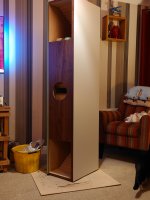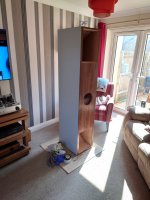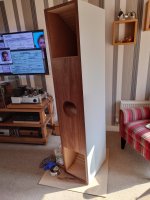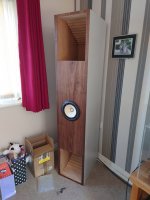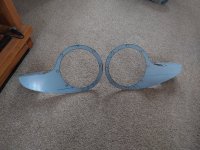What kind of wire? I recommend fine, solid guage wire. Teflon is better than PVC. I typically use 24g solid pulled from CAT5/6 cable.
Do not be tempted to use something fat.
dave
Do not be tempted to use something fat.
dave
I use pure silver 99.999 from 'wires.co.uk'What kind of wire? I recommend fine, solid guage wire. Teflon is better than PVC. I typically use 24g solid pulled from CAT5/6 cable.
Do not be tempted to use something fat.
dave
0.5mm 6 each side, plaited.
Teflon tube from eBay..China actually...cheapest, and exactly the same as any other teflon.
I use pure silver 99.999 from 'wires.co.uk'
0.5mm 6 each side, plaited.
Teflon tube from eBay..China actually...cheapest, and exactly the same as any other teflon.
Let us know how it works, it is stranded, and 6 25guage strands. The strands are thin enuff, but one might work better. Silver i am skeptical about.
This is my top choice for reference. https://www.takefiveaudio.com/products/907-neotech-upocc-24-awg-teflon-insulation-cryo-treated/
dave
Here. A friend whom works for a hifi mag recommended it...and very cheap...I love silver cables..reveals everything...what I like.Let us know how it works, it is stranded, and 6 25guage strands. The strands are thin enuff, but one might work better. Silver i am skeptical about.
This is my top choice for reference. https://www.takefiveaudio.com/products/907-neotech-upocc-24-awg-teflon-insulation-cryo-treated/
dave
https://www.wires.co.uk/acatalog/ag9999_bare.html
Without getting involved in matters of personal opinion, I'd quietly note that silver and teflon are one of the worst combinations for tribolelectric issues you can create as far as commonly available wire materials go. Especially if the teflon tube in question is oversized relative to the wire itself, thereby allowing mechanical movement. I would be very careful about employing it in any circumstances when it isn't necessary for xyz reason.
Ohh I see. I did not know that. What would you recommend as a sleeve for silver wire?Without getting involved in matters of personal opinion, I'd quietly note that silver and teflon are one of the worst combinations for tribolelectric issues you can create as far as commonly available wire materials go. Especially if the teflon tube in question is oversized relative to the wire itself, thereby allowing mechanical movement. I would be very careful about employing it in any circumstances when it isn't necessary for xyz reason.
I see some DIY companies recommend PTFE sleeving for solid core silver wire?
I wouldn't personally use silver at all since it's expensive & at best has only just under 7% higher conductivity than a quality copper, gauge for gauge. If you must though, PP should solve that issue.Ohh I see. I did not know that. What would you recommend as a sleeve for silver wire?
I see some DIY companies recommend PTFE sleeving for solid core silver wire?
Assuming you want an honest answer about why -in many cases the vendors have a rather limited understanding of what they are actually doing, and because Teflon has low dissipation factor / losses, they simply state its superiority in this regard without mentioning (or even knowing) there are other factors.
I just personally prefer silver having heard many copper alternatives. These internal cables cost me about £60 which I think isn't too bad..
Anyway away from cables...
They are about to be fired up.....
Anyway away from cables...
They are about to be fired up.....
Don't get me wrong, I've nothing against silver as a material other than the fact that it's unnecessary; I'm just noting that in applications where mechanical vibration is likely, a combination between it and Teflon is likely to run into triboelectric issues & audible noise and therefore best avoided. It's happened to me (and others) often enough. For internal wire, in this sort of application, about £3 should be more than sufficient depending on length. I quite like Supra Classic 1.6 for example.I just personally prefer silver having heard many copper alternatives. These internal cables cost me about £60 which I think isn't too bad..
Last edited:
What sort of noise?Don't get me wrong, I've nothing against silver as a material other than the fact that it's unnecessary; I'm just noting that in applications where mechanical vibration is likely, a combination between it and Teflon is likely to run into triboelectric issues & audible noise and therefore best avoided. It's happened to me (and others) often enough.
I will certainly keep an eye (or ear) out for it...
Last edited by a moderator:
Varies a little depending on extent and by nature if you get it, it will usually be intermittent as it's inherently microphony & generated by vibration & movement. Usually something like HF ringing potentially dropping into the midband. I suspect (I'm hardly the first) that this is one reason silver wire or silver-plated wire frequently has a reputation for HF distortion, as it's often found combined with Teflon, and also frequently used in an inadequate gauge for an intended application.
What do people think on the efficiency of these.
I was going to consider getting a 4 watt amp, assuming these are in the high 90s efficiency wise
I was going to consider getting a 4 watt amp, assuming these are in the high 90s efficiency wise
BeautifulVery impressive work, you're flying along with the build. One possibility for the tweeter:
View attachment 1034203
That was my plan before passing the torch. Same driver setup and similar style cabinet, $12,000!
Mid 90s. Umless the room is BIG and you play really loud, 4w should be finr. Keep in mind that the clipping behaviour is more important than the absolute power.What do people think on the efficiency of these.
I was going to consider getting a 4 watt amp, assuming these are in the high 90s efficiency wise
dave
- Home
- Loudspeakers
- Full Range
- Kirishima Fostex FE208e∑ build
